It was January 14, 2000. Despite the apocalyptic predictions that frightened millions of people with the supposed end of the world due to the arrival of the new millennium, life went on as usual. After ten in the morning, Santiago de Cuba’s sun was already rolling like an elastic marble on the runway of the Antonio Maceo Airport, when a private jet made its instant appearance. The purring of the engine faded and the steps began to unfold.
With firm steps and a smile that exuded charisma, María Elena Suárez, an employee of International Traffic, walked up the ramp to the white Cessna to receive the tourist and lead him to the protocol room of the air terminal. The figure that emerged from inside the aircraft was unmistakable, but she did not immediately notice his aura of a star.
He came “disguised.” He wore black plastic glasses, a baseball cap, a blue shirt with sleeves rolled up to the elbows, beige pleated pants, and a pair of sandals. Other employees did suspect from the beginning, since they noticed a certain resemblance to a famous person. However, they continued to be incredulous that it was him. What was someone of his stature doing in Cuba? Did he arrive without anyone announcing it…not even the press?
It was all very strange. When they checked the passports, the mystery ended and the magic happened. “James Paul McCartney,” Maria Elena read and looked at him in astonishment, trying to associate that aged face with the rebellious boy with the “pumpkin” hairstyle she had seen in music videos on TV: “Yes, the one from the Beatles,” the newcomer clarified pleasantly.
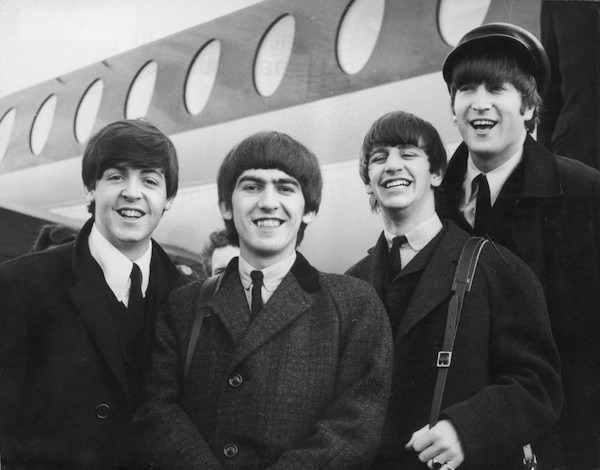
He was accompanied by his daughter Stella, a renowned fashion designer, his son James Louis, who followed in his father’s footsteps in music, and the pilot. Then Maria Elena, as if struck by lightning, understood the magnitude of the moment: she was the first Cuban person to interact with Sir Paul McCartney, a British knight and living rock legend for the legendary quartet he formed with John Lennon, George Harrison and Ringo Star.
***
The small aircraft that brought McCartney arrived from Providenciales, in the Turks and Caicos Islands, a British overseas territory southeast of the Bahamas. On the eve of the flight, Ariel Pevida received an email from InterIsland Airways, headed by Mr. Lyndon Gardiner. Not only did they ask him to organize the trip, they also begged him to make sure everything went perfectly since it was someone from the world of show business.
“I made the pertinent verifications with the Institute of Civil Aeronautics in Havana and with the Santiago airport stations; in fact, they already had the authorization. From there I asked the Cubanacán travel agency to provide an excellent tour guide because it was a special client, without going into details,” Pevida, who was then responsible for coordinating the tour, recalled to OnCuba.
“Once the formalities were completed, I considered that my work in that operation was finished. I never knew who the famous passenger was. I found out once he landed in Santiago. I admire the music of The Beatles, but I was never interested in meeting any of them individually. Ah, but if it were to see them in a quartet, I would have moved heaven and earth to see them,” he adds.
For his part, Onil Nápoles, director of the Antonio Maceo airport at the time of the arrival, specifies: “The story is that the pilot had been to Santiago several times, taking celebrities. Paul told him that he wanted to see Cuba and the pilot suggested going to Santiago. He made a reservation in the lounge and that’s where it all began. They put him in a bus with a guide and he went on a tour of several iconic spots in the city. Our role was to welcome him and see him off upon his return. We gave him several types of Cuban rum. ‘I’m going to be drunk until November,’ he said in perfect Spanish and invited us to take a photo with him.” McCartney had studied the language and spoke it quite fluently.
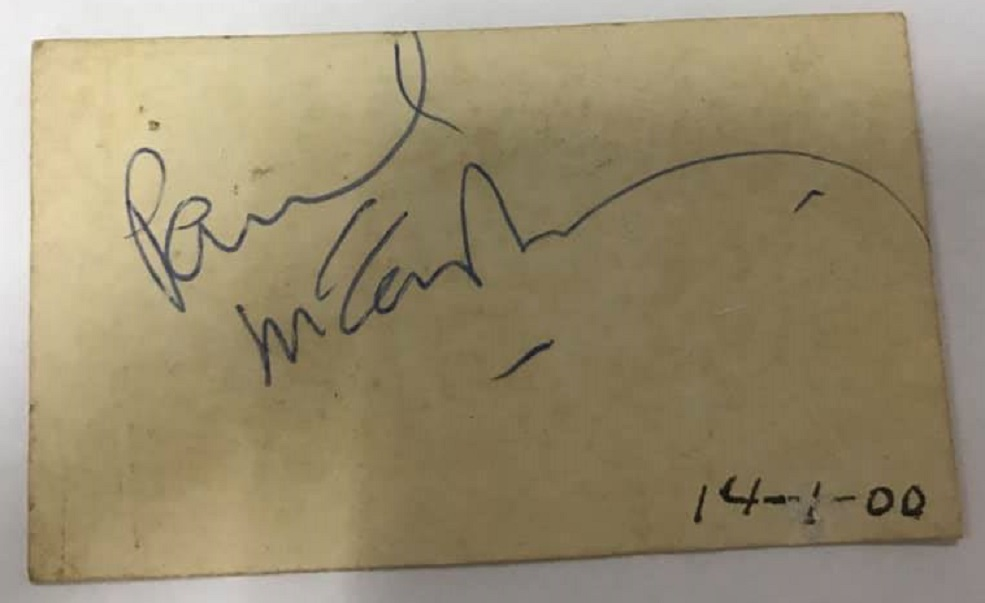
Carlos Manuel Rivera captured the image of the Beatles with a group of airport workers. Like the barefoot man on the zebra crossing in Abbey Road or the black carnation going down the stairs in Your Mother
Should Know, Paul is once again the “strange” man in the photo. Not only does he look “squashed” (he is almost 1.80 meters tall), but, trying to hide his identity, he had put on some dark glasses with a certain “Martian vibe” that turned out to be significantly striking. Paul always stands out, no matter the setting. This is the best-known photograph or the only one published on social media of his journey through Santiago.
No paparazzi were chasing him nor were these the current times, when everyone has a cell phone in hand. The story would have been different. And the hysteria. However, that is not the “only” photographic record that exists of the fleeting stay, as has been wrongly maintained during these two decades. In fact, Paul took several pictures, politely signed as many autographs as he could, and smiled when some confident Santiago resident shouted “John” (Lennon) or “Yesterday.” But, probably out of respect for his express request for privacy, they were shelved. Perhaps one day new evidence will come to light, but in the interesting book El Sargento Pimienta vino a Cuba en un submarino amarillo (Sergeant Pepper came to Cuba in a yellow submarine), by journalist Ernesto Juan Castellanos, published in 2000, details of the visit are collected and a graphic appendix containing three curious photographs of Paul in Santiago: one walking down the street with his children and the others at the Casa de la Trova.
***
The guide turned out to be Walfrido Álvarez, who, taking into account the interests of the illustrious traveler — especially considering that he wanted to maintain the greatest possible discretion — demonstrated his qualities as a magnificent professional and improvised a tour of barely four hours, ensuring that the visitor could take away in that short time the most complete panoramic view of the eastern city. With its noble facades from the colonial era, cheerfully illuminated by the day, the graceful and hospitable physiognomy of its people, and without the extreme nervous tension of the great capital, Santiago became for Paul, without intending it, the face of the country.
The Morro Castle Museum, tarnished by centuries of sun and salt, was the first destination of the tour. Together with his guide and his children, McCartney climbed to the platform of the Santísima Trinidad, the highest point of this vintage rock architecture, from where one is usually fascinated by the legends of the fortification declared a World Heritage Site in 1998 and can even see the spirits of the naval battle still wandering through that Mediterranean landscape of supernatural beauty.
When leaving, Paul wrote in the book of distinguished visitors: “Olá. Many thanks. Viva la Revolution!!” The possibility that the Liverpool native born in 1942 dedicated such a phrase has been questioned by some antagonistic people. However, it was real and appears recorded in the book El Sargento Pimienta...
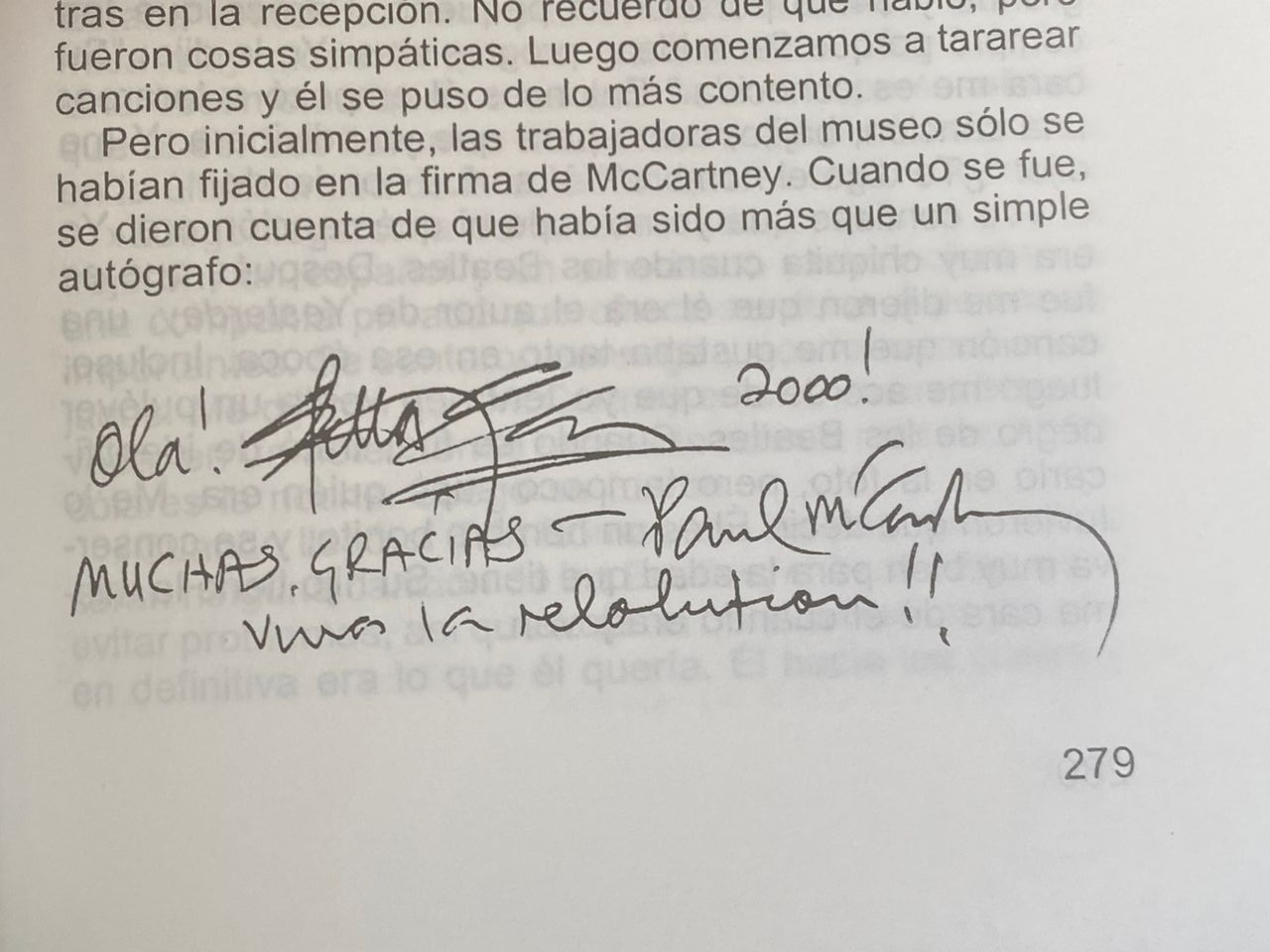
In the picturesque souvenir kiosks, located in the vicinity of the castle, he bought a couple of Cuban-themed T-shirts. Invited by the guide, he went to lunch at the nearby restaurant El Morro. According to the voucher that the clerk Reina Reyes gave to the chef Santiago Téllez, the requested menu consisted of three tortillas with cheese, bread, mixed salads, rice, plantain chatinos. For dessert: ice cream and coffee. Reina would note in a documentary series that he liked the chocolate ice cream a lot, and that she also served him a Mayabe beer and a Delicias brand pineapple cocktail.
Eighteen years later, next to table number seven used by McCartney and family for that graceful lunch by the Caribbean Sea, a life-size statue of the musician was placed. It is the work of the Santiago sculptor Mariano Frómeta Stevens. “I used marble with a bronze patina and, as you can see, Paul, sitting, rests one arm on the table while the other rests below. There I tried to reflect on the relaxing posture, and the phlegm that characterizes the Englishman, in addition to listening to the suggestions of those who work at the restaurant and were there that day. Yes, I do like The Beatles. They are classics and my generation knew their music very well. They are unrepeatable,” declared the plastic artist in 2018 to Miguel Ángel Gaínza, cultural journalist of the provincial weekly Sierra Maestra.
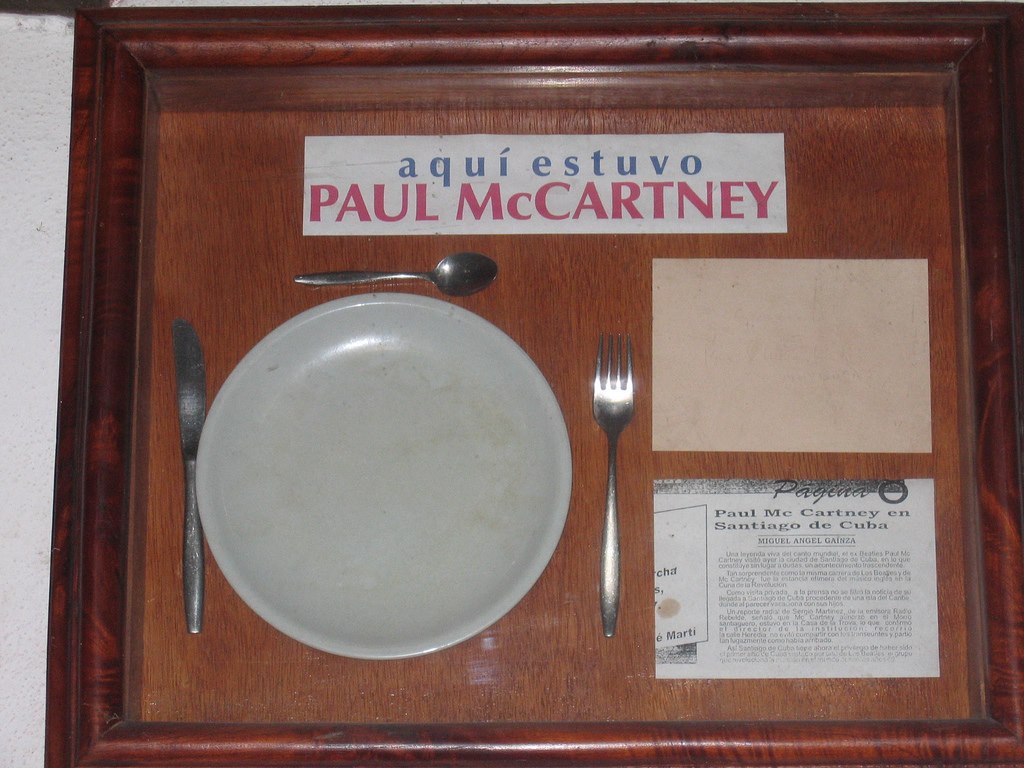
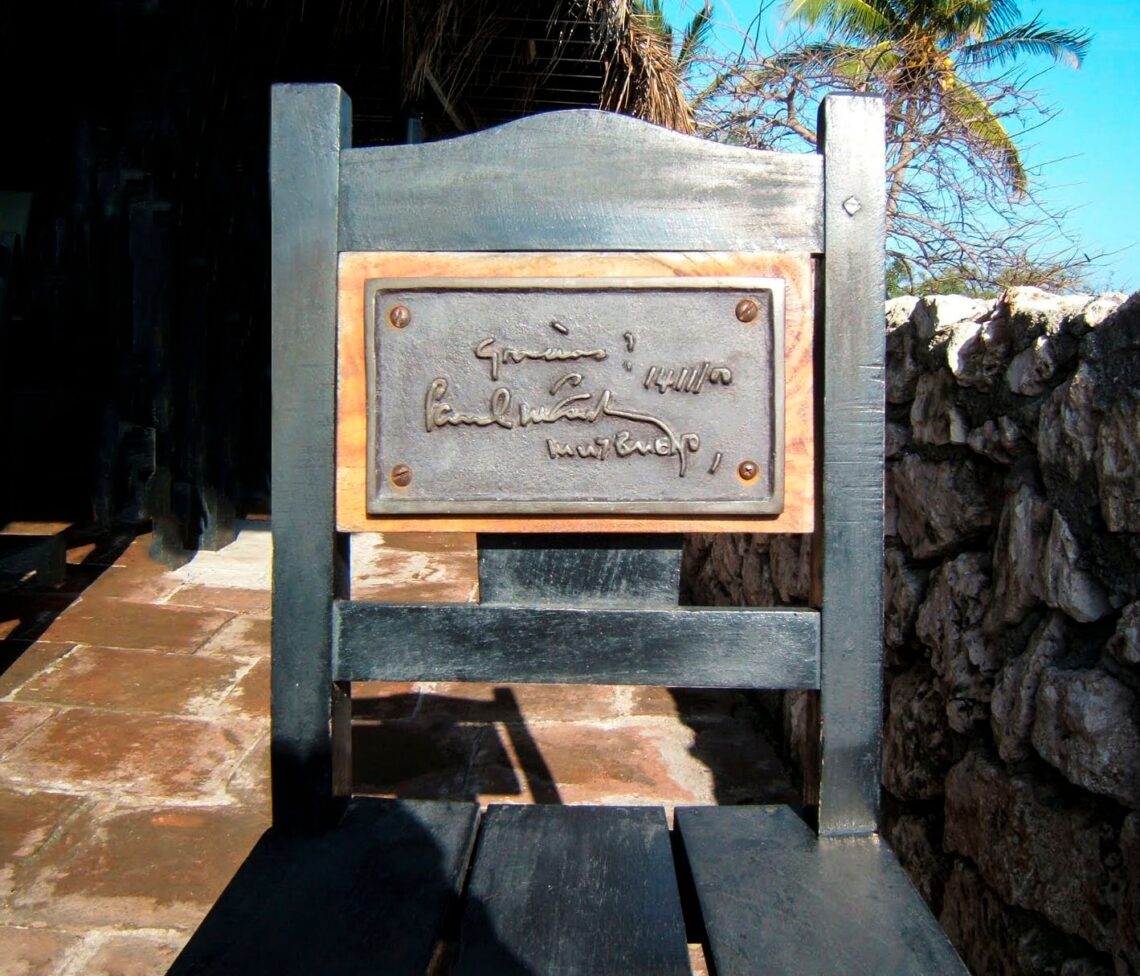
As an exceptional attraction, the restaurant kept the chair, plate and cutlery used by Paul, as well as his thanks printed on a napkin: “Gracias. Muy bueno.” Some affirms he said: “Volveré.” They are still waiting for him there.
***
The experience at El Morro and the restaurant were the perfect appetizer. The main course: the historic center of Santiago. Cuba’s musical trail led him to the Pepe Sánchez Casa de la Trova, in the very heart of the city.
At about one in the afternoon, the minibus he was riding in parked on one side of Céspedes Park, on the corner in front of the Bank. McCartney and company had to cross the square in front of the Cathedral on foot, take the sidewalk in front of the Casagranda Hotel, and jump over the narrow Heredia Street to enter the traditional mansion. One of the passers-by who saw him at that moment was Vincent Guillon, a Frenchman captivated by the trova: “It was about twelve o’clock when I was walking along Heredia and I suddenly saw a crowd. I thought it was a row, a robbery or something like that, when a man who was with his family given way, I don’t remember if there were five of them. I didn’t recognize him right away, he was wearing a cap and dark glasses, but I did notice a very peculiar walk, very Anglo-Saxon.”
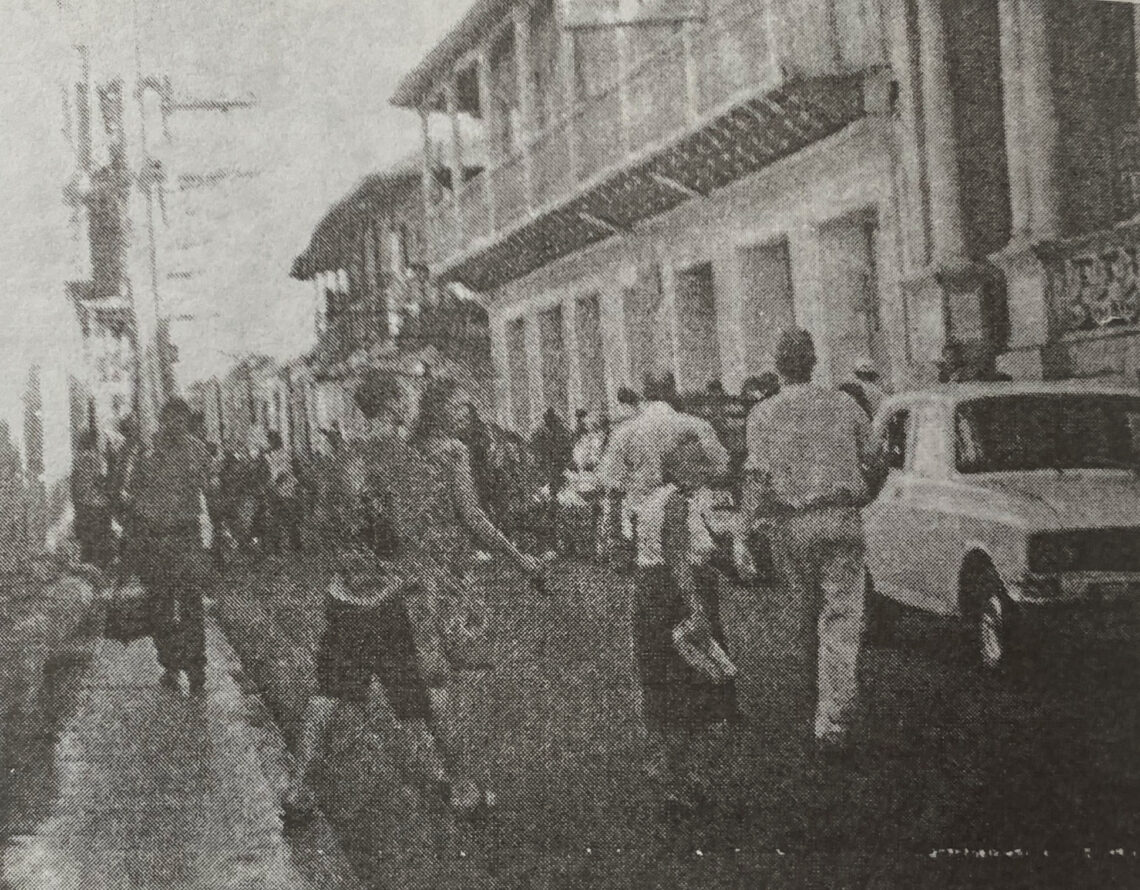
The first thing the Beatle did when he crossed the threshold of the Casa was to take an interest in the catalog and buy a dozen homemade records. Among them, titles by Benny Moré, Eliades Ochoa, Sindo Garay, orchestras from the 1950s, guajiras, Los Guanches, Septeto Turquino; while his children bought CDs of popular dance music: Los Van Van, Aragón, NG la Banda and Adalberto Álvarez y su Son.
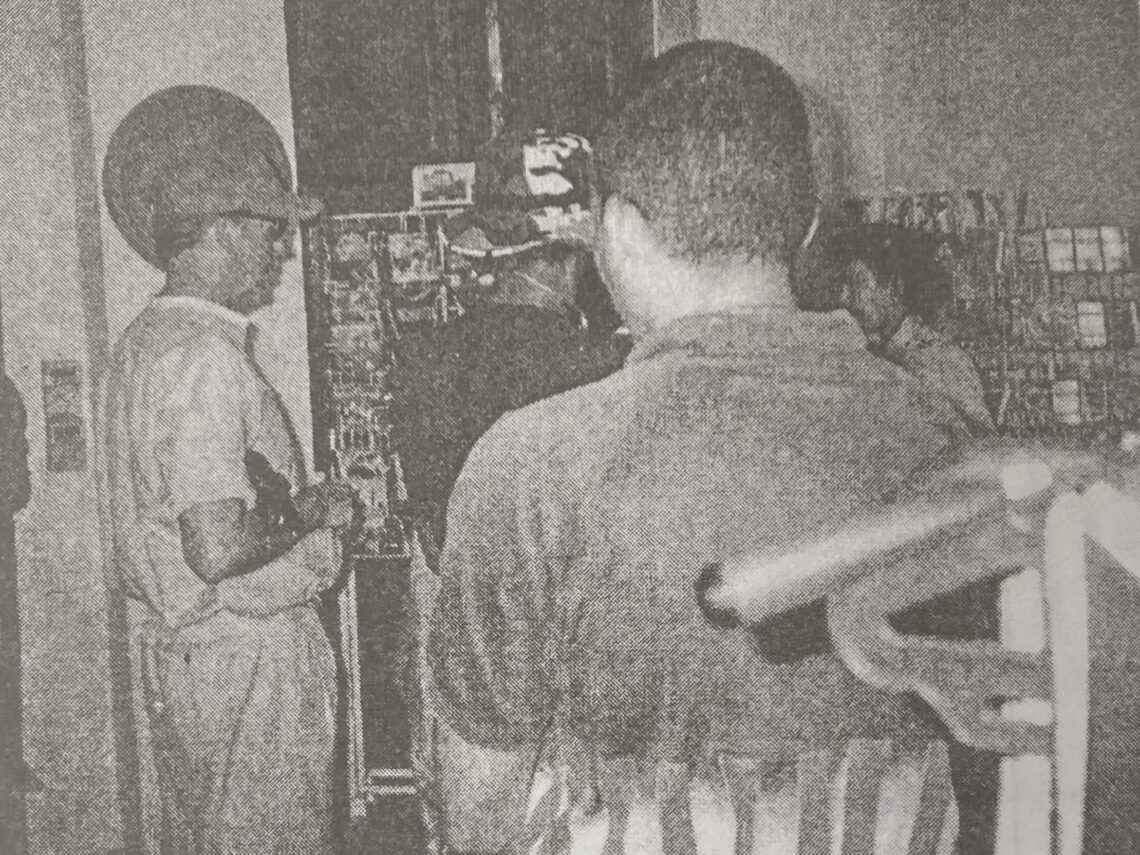
At that time, the then quintet Moneda Nacional, directed by Daniel Castillo, was playing traditional music with flavor. “It turns out that we had already finished work that day and we were collecting the instruments when the director of the Casa de la Trova appeared. He asked us to stay a little longer because Paul McCartney had arrived at the airport and they had told him he wanted to go to the Casa de la Trova,” recalls Daniel Cos, who was the tres player of the group.
“Imagine, they didn’t pay for it, but for us, it was an honor to play for such an important figure in the world of music. I remember that he came in and stayed at the back, discreetly reclining. He arrived with a cap and glasses, and since we were used to seeing him with long hair, we almost didn’t recognize him. Then the place started to fill up with people who had already found out who was there and then he came to sit in the front row. I was concentrating on playing and I couldn’t pay attention to everything he did or said, and many years have passed and the details are lost, but I think he was pleased with the time he spent with us,” says Cos.
Another exceptional witness of the half-hour that Paul enjoyed between sones and guarachas in that remarkable atmosphere was the outstanding singer-songwriter José Aquiles. “I had just passed by La Trova, where my colleague René Urquijo approached me: ‘Hey, stay in the area, they say that Paul McCartney arrived in a small aircraft and is coming here.’ I thought it was a joke, I didn’t believe it and I went home to have lunch. I was in the middle of that when the phone rang. It was the director of the Casa de la Trova, Julio Domínguez, insisting that it was real. Julio was a serious person, so I got on my motorcycle and headed off there,” Aquiles recalls. Even so, the fear that it was a “joke” did not leave him the whole way.
“When I saw him at the door of the Casa de la Trova, it seemed incredible to me. I said to Julio Domínguez: ‘Look at him there. That’s the man.’ The first thing he did was stop at the little Artex store, to the right of the entrance, to ask about the records for sale. Urquijo and I had the chance to talk to him there. He told us that he knew Cuban music. In the middle of that exchange, two boys appeared with a camera and hid behind some clothes hangers to surreptitiously take photos of him. I think I saw one in a book. When Paul realized, as he didn’t want that publicity, he went into the main room for the performance of Moneda Nacional.”
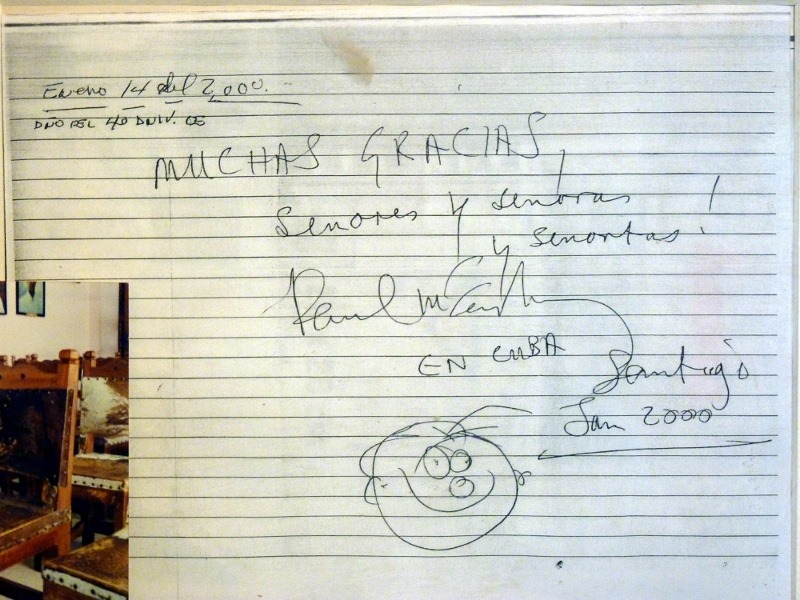
Another of the urban legends that have come to light is that Paul “played Cuban music with claves,” when in reality he only accompanied the beat with his hands. “He never had a clave in his hand, but I did see that he ‘swayed’ in his chair. He followed the rhythm,” Guillon said.
Aquiles sat right behind the honoree. “He showed identification with the Cuban clave. At the end, he signed an autograph on a page of the identity card, which was the booklet kind. I can tell you that there were people outside, looking through the barred windows, who never realized that Paul McCartney was sitting there. This is in summary what we experienced at La Trova. That was how that afternoon time stopped and the moment became eternal. Now that One Hundred Years of Solitude is in fashion, I would say that for me that was part of the magical realism of Santiago,” says Aquiles, letting out a slight laugh.
***
They say that he went everywhere humming or whistling softly. Paul McCartney also visited the cigar factory in La Alameda, where he exchanged with the cigar rollers and asked for “real” Cuban cigars, the ones that cost a peso. He passed by the old Moncada barracks, the Antonio Maceo Plaza de la Revolución, and the Capitulation Tree in San Juan. Then the minibus took the same route, along the ring road, to the airport.
When the people of Santiago “woke up,” the Beatle was no longer there. They were caught off guard. At about four in the afternoon, Paul McCartney left for his paradise in Providenciales. The visit that many Beatle lovers had always dreamed of took place incognito, 969 kilometers from Havana. The national press, immersed in the campaign for the return of the child Elián González, did not mention the event until a week later. “Paul McCartney, former member of the Beatles, visited this city from Margarita Island, Venezuela, intending to get in touch with the roots of Cuban music and the hospitality of its people. The mythical figure of world song only spent a few hours in the eastern city, where he arrived in his private aircraft, although he made a fruitful tour,” reported Granma on January 23.
Paul McCartney, one of the most influential artists of contemporary times, crowned the modern cultural history of Santiago with his presence. The emotion of the privileged witnesses was authentic. Even though the music of the British band had been disdained and almost persecuted years ago, the legacy of the Beatles had its clandestine sanctuary in the soul of the island.
“Nostalgia is still the same as before,” García Márquez judged in an article on Lennon’s death. There he expressed: “I have the impression that the world was the same from my birth until the Beatles began to sing. Everything changed then.” Without wishing to tarnish Gabo’s foresight, nostalgia is no longer what it seems, it is not that of his time. Fewer and fewer people have the good fortune to revel in the pastoral melancholy of memory, especially when the mind has so many emerging and serious dilemmas to resolve. That is why, a quarter of a century later, few ― even among those who say they are under the power of Beatlemania ― will remember the five hours that the genius Paul McCartney spent in Santiago de Cuba.










